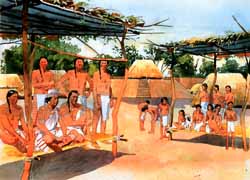
 |
|
An artist's conception of buildings around the central plaza of a Mississippian settlement. Note the stockaded wall and flat-top earthen mound in the background. |
Mississippians used new construction techniques for buildings. For one thing, they recessed their house floors two to three feet into the ground, making the basin semi- subterranean. Instead of digging a hole for each upright post as had been done for thousands of years, they dug a narrow trench along the basin edge where they wanted to build a wall. Roof poles were lashed to the building walls with fiber cord. They then wove smaller sticks through the upright posts and poles and covered the entire house with thick bundles of long grass or reeds, also known as thatch. Using these techniques, Mississippians built homes and large public buildings.
Inside a home you would find a fireplace, especially during the cold-weather months, and nearby would be pits for temporarily storing food. You also might also find pole frame platforms for sitting and sleeping. Tools and other possessions were stored beneath the platforms. Can you imagine your entire family living in one room which was the kitchen, living room, and bedroom combined? These people spent much of their time outside.
Mississippian buildings ranged in size from family homes, which consisted of a single room perhaps 5.5 m (18 ft) long and 3.6 m (11.8 ft) wide, to large public buildings. One at Dickson Mounds was 25 m (82 ft) long and 14.6 m (47.9 ft) wide. The larger buildings also were just one room. Interior posts were placed to support the large roof. The public buildings were used for meetings and perhaps dances and rituals.
Archaeologists have learned a lot about Mississippian buildings from those that burned. In many cases, the burning wooden posts, fiber cordage, and thatch were turned into charcoal instead of ash. In the remains of some buildings, archaeologists have found poles from wall and roof sections still held together with fiber cord tied with knots, bits of mud used to plaster lower side walls, and charred fragments of thatch bundles lying on the floor.
In burned structures, archaeologists also find tools and other items lying on the floor just where they were on the day the building caught fire. Why did the buildings burn? Perhaps it was started by sparks rising from the cooking fire, an outside fire on a windy day, or a natural fire caused by lighting. Possibly intruders burned the house or perhaps the fire was intentionally set to honor people who once lived in the house but had died.
|
|
Copyright © 2000 Illinois State Museum